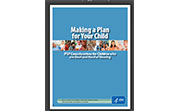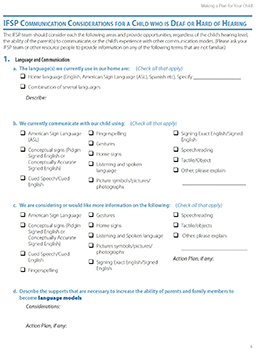Making a Plan: IFSP Considerations for Children Who are Deaf and Hard of Hearing
Factor 5 Highlight
 |
Document Description

Developed by Janet DesGeorges, Executive Director, Hands & Voices
This document is designed to guide conversations between parents and their Individualized Family Service Plan (IFSP) teams as they address the unique language and communication considerations for a child who is deaf or hard of hearing. It is especially critical to include this type of planning document, addressing topics that are unique to facilitating linguistic competence for children who are deaf or hard of hearing, in the development of the IFSP as this does not always occur automatically in the Part C EHDI system. As being deaf or hard of hearing is "low incidence," it is often up to the family to ensure that topics such as language, communication approaches and strategies, access to support, and other considerations unique to planning for a child who is deaf or hard of hearing are addressed.
The plan's format is targeted for use by parents, with the support of the IFSP team. By having a plan in writing, the goal is to empower families to know what to ask for and to address with the IFSP team during the development of the IFSP. It is also appropriate for this plan to be used by early interventionists and other professionals to guide families in thinking about the features of successful intervention for children who are deaf or hard of hearing. The 'fill in the blanks' template enables users to create recommendations that are individualized.
The features included in the plan are intended to facilitate getting the appropriate services in place regarding:
- language and communication approaches and strategies;
- assistive technologies (e.g., hearing aids, FM systems, videophones, adaptive toys);
- family training, counseling, home visits, and other supports to promote family competence as language models and primary advocates for their child;
- peers and role models who are deaf or hard of hearing;
- inclusion of a family service coordinator as one of the family's primary service providers (note: Part C of IDEA states, "The IFSP must include the name of the service coordinator from the profession most immediately relevant to the child's or family's needs [or who is otherwise qualified to carry out all applicable responsibilities under this part], who will be responsible for the implementation of the IFSP and coordination with other agencies and persons." - Sec. 303.344(g)(1). Available from ASHA);
- qualified, knowledgeable service providers who have expertise, experience, training, and certification in assessing and working with children from birth to age three who are deaf or hard of hearing, specific to the language and communication approaches and strategies identified through the IFSP; and
- assessments and curriculums that are tailored for children who are deaf or hard of hearing.
Links to the plan: Making a Plan for Your Child (PDF) and Desarrolle un Plan Para su Hijo (PDF) (translated into Spanish by the Texas School for the Deaf)
Document Development
The document Making a Plan: IFSP Considerations for Children Who are Deaf and Hard of Hearing was developed by a longstanding sub-committee, The Parent-to-Parent Committee of the Center for Disease Control (CDC) and EHDI. The committee is open to any interested individuals, including professionals, parents, and deaf or hard of hearing adults. CDC functioned as a liaison, provided the resources to produce this product, and has made it available to the public at no cost via its website. The committee meets by phone once a month and is co-chaired by two parents, Janet DesGeorges and Terri Patterson. This and other resources developed by this committee can be found at Free Resources.
For the development of the IFSP communication plan, the template from the Colorado Deaf Child Bill of Rights (DCBR) communication plan was used. That particular plan was developed for children ages 3 and up. The committee took the template and revised it for the Part C (birth to age 3) population. It is available at Bill of Rights for Deaf and Hard of Hearing Children.
Use of the Document
At the individual level, families who are using the plan with their IFSP teams develop family goals and outcomes to address the strengths and challenges specific to their child. As families gain knowledge about emerging communication considerations and issues to guide them in making decisions related to language and communication, their confidence grows.
At the programmatic level, some programs are implementing use of the communication plan within their programs on a voluntary basis. In parent-to-parent support organizations such as Hands & Voices, information about the communication plan has been disseminated through their public forums.
Currently, there is no legislation in any state requiring the use of the communication plan for the Part C population. However, several states, including Colorado, Connecticut, and New Mexico, have communication plans that are mandated for use at the school-age level, and at least one state (Colorado) is researching options to expand the mandate for the birth to age 3 populations into the current DCBR structure.
Tips for Using the Plan
Tips for using the plan:
- It takes time to create a meaningful plan.
- The plan is most effective when it is created via a collaborative team approach.
- The development of an effective plan includes thoughtful insight and discussion.
- The plan should focus on the individual child's communication needs.
- There is no right or wrong way to fill out the document; it can be modified for specific needs.
- The plan should be a fluid document. It may change over time so don't worry about having it "all figured out" from the beginning--this is a tool to help that process.
- If there is something in the plan template that parents don't understand, they should ask the IFSP team for clarification. If no one at the table can answer the parents' question(s), other qualified and/or experienced individuals should be sought who may not be in attendance.
- Do not view the plan as just another form to fill out; use it to guide service provision.
- Do not fill out the plan without parent participation.
Advice
There are several ways that use of the plan can be implemented at a state-wide level:
- Legislative mandate: Follow the lead of the DCBR implementation and consider a legislative mandate. Information on states that have these types of bills can be found at:
- National Deaf Education Project (a website sponsored by Hands & Voices)
- Hands & Voices (Google "DCBR" in the search engine)
- National Association of the Deaf
- Voluntary use: Early intervention programs can take this document, print it, and disseminate it liberally to families. States that produce resource documents for families with newly identified children should include it in the resources available. Trainings on how to use the document can be done by members of the CDC committee who helped develop it.
- Parent request at an IFSP meeting per IDEA regulations: Parents have a right to include information they bring to an IFSP meeting. They can download and bring the document and request that it be a part of the IFSP development.
Links to the plan:
Making a Plan for Your Child (PDF)
Desarrolle un Plan Para su Hijo (PDF) (translated into Spanish by the Texas School for the Deaf)
